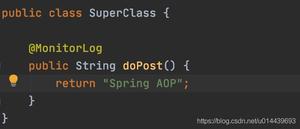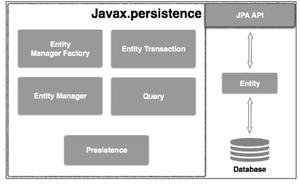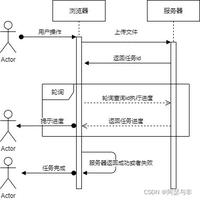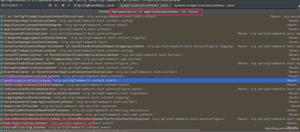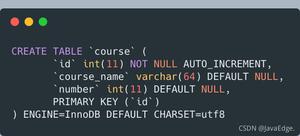6.spring:AOP(注解)
本文内容纲要:6.spring:AOP(注解)
spring Aop
AOP面向切面编程,与OOP面向对象编程相辅相成
AOP中最基本的单元是切面
问题:
代码混乱:越来越多的业务需求(日志&验证)加入后,原有的业务方法急剧膨胀,每个方法在处理核心代码的同时还必须兼顾其他的多个关注点
代码分散,以日志为例,知识为了满足这一单一的需求,就不得不在代码块中里多次调用重复的日志代码,如果日志发生变化,必须修改所有的模块
简介:
AOP:面向切面编程,是一种新的方法,式传统OOP面向对象编程的补充
AOP主要编程对象是切面,而切面模块化横切的关注点
在应用AOP编程时,仍需要定义公共的功能,但可以明确定义的功能在哪,以什么方式应用,并且不必修改影响的类,这样横切关注点就被模块化到特殊的
对象(切面)里
AOP的好处:
->每个事物逻辑位于一个位置,代码不分散,便于维护
->业务模块化更简洁,只包含核心的业务代码
AOP术语:
切面(Aspect):横切关注点被模块化的特殊对象
通知(Advice):切换必须完成的工作
目标(Target):被通知的对象
代理(Proxy):向目标对象应用的通知之后创建的对象
连接点(Joinpoint):程序执行的特定位置
切点(pointcut):每个类都有若干个连接点,
AOP即使通过定位到特定的连接点
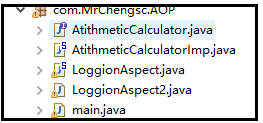
每次做方法的时候,都在执行之前和之后都有相关的打印操作!AtithmeticCalculator.java
public interface AtithmeticCalculator {
int add(int i,int j);
int sub(int i,int j);
int mul(int i,int j);
int div(int i,int j);
}
AtithmeticCalculatorImp.java
接口中方法的实现。
@Componentpublic class AtithmeticCalculatorImp implements AtithmeticCalculator{
public int add(int i, int j) {
int res = i + j;
return res;
}
public int sub(int i, int j) {
int res = i - j;
return res;
}
public int mul(int i, int j) {
int res = i * j;
return res;
}
public int div(int i, int j) {
int res = i / j;
return res;
}
}
LoggionAspect.java
切面类
//把这个类升级称为一个切面:返给到IOC容器中---->在声明为一个注解
@Order(2)
@Aspect
@Component
public class LoggionAspect {
@Before("execution(public * com.MrChengsc.AOP.AtithmeticCalculator.*(..))")
public void beforeMethod(JoinPoint joinPoint){
String methodName = joinPoint.getSignature().getName();
Object [] args = joinPoint.getArgs();
System.out.println("The method " + methodName + " begins with " + Arrays.asList(args));
}
/**
* 在方法执行之后执行的代码. 无论该方法是否出现异常
*/
@After("execution(public * com.MrChengsc.AOP.AtithmeticCalculator.*(..))")
public void afterMethod(JoinPoint joinPoint){
String methodName = joinPoint.getSignature().getName();
System.out.println("The method " + methodName + " ends");
}
/**
* 在方法法正常结束受执行的代码
* 返回通知是可以访问到方法的返回值的!
*/
@AfterReturning(value="execution(public * com.MrChengsc.AOP.AtithmeticCalculator.*(..))",
returning="result")
public void afterReturning(JoinPoint joinPoint, Object result){
String methodName = joinPoint.getSignature().getName();
System.out.println("The method " + methodName + " ends with " + result);
}
/**
* 在目标方法出现异常时会执行的代码.
* 可以访问到异常对象; 且可以指定在出现特定异常时在执行通知代码
*/
@AfterThrowing(value="execution(public * com.MrChengsc.AOP.AtithmeticCalculator.*(..))",throwing="e")
public void afterThrowing(JoinPoint joinPoint, Exception e){
String methodName = joinPoint.getSignature().getName();
System.out.println("The method " + methodName + " occurs excetion:" + e);
}
//环绕通知
//需要携带ProceedingJoinPoint这个类型的参数
//环绕通知类似动态代理的全类名:ProceedingJoinPoint可以绝对是否执行目标方法
//必须要有返回值,返回值即为目标方法的返回值
// @Around("execution(public * com.MrChengsc.AOP.AtithmeticCalculator.*(..))")
// public Object aroundMethod(ProceedingJoinPoint proceedingJoinPoint){
// System.out.println("@Around");
// //返回值
// Object result = null;
// //前置通知
// String methodName = proceedingJoinPoint.getSignature().getName();
// try {
// //前置通知
// System.out.println("The methodName:" + methodName + " _The args :" + Arrays.asList(proceedingJoinPoint.getArgs()));
// //执行目标方法
// result = proceedingJoinPoint.proceed();
// //后置通知
// System.out.println("End result:" + result);
// } catch (Throwable e) {
// //e.printStackTrace();
// //异常通知
// System.out.println("Exception:" + e);
// }
// //后置通知
// System.out.println("End...");
// //返回值
// return result;
// }
}
LoggionAspect2.java
切面类2//把这个类升级称为一个切面:返给到IOC容器中---->在声明为一个注解
@Order(1)
@Aspect
@Component
public class LoggionAspect2 {
//定义一个方法用于切点表达式
//一般的该方法不需要填入其他的代码
@Pointcut("execution(public * com.MrChengsc.AOP.AtithmeticCalculator.*(..))")
public void declareJointPointExpression(){ }
@Before("declareJointPointExpression()")
public void beforeMethod1(JoinPoint joinPoint){
System.out.println("--->beforeMethod1");
String methodName = joinPoint.getSignature().getName();
Object [] args = joinPoint.getArgs();
System.out.println("The method " + methodName + " begins with " + Arrays.asList(args));
System.out.println("--->beforeMethod1");
}
/**
* 在方法执行之后执行的代码. 无论该方法是否出现异常
*/
@After("declareJointPointExpression()")
public void afterMethod1(JoinPoint joinPoint){
String methodName = joinPoint.getSignature().getName();
System.out.println("The method " + methodName + " ends");
}
/**
* 在方法法正常结束受执行的代码
* 返回通知是可以访问到方法的返回值的!
*/
@AfterReturning(value="declareJointPointExpression())",
returning="result")
public void afterReturning1(JoinPoint joinPoint, Object result){
String methodName = joinPoint.getSignature().getName();
System.out.println("The method " + methodName + " ends with " + result);
}
/**
* 在目标方法出现异常时会执行的代码.
* 可以访问到异常对象; 且可以指定在出现特定异常时在执行通知代码
*/
@AfterThrowing(value="declareJointPointExpression()",throwing="e")
public void afterThrowing1(JoinPoint joinPoint, Exception e){
String methodName = joinPoint.getSignature().getName();
System.out.println("The method " + methodName + " occurs excetion:" + e);
}
//环绕通知
//需要携带ProceedingJoinPoint这个类型的参数
//环绕通知类似动态代理的全类名:ProceedingJoinPoint可以绝对是否执行目标方法
//必须要有返回值,返回值即为目标方法的返回值
// @Around("execution(public * com.MrChengsc.AOP.AtithmeticCalculator.*(..))")
// public Object aroundMethod(ProceedingJoinPoint proceedingJoinPoint){
// System.out.println("@Around");
// //返回值
// Object result = null;
// //前置通知
// String methodName = proceedingJoinPoint.getSignature().getName();
// try {
// //前置通知
// System.out.println("The methodName:" + methodName + " _The args :" + Arrays.asList(proceedingJoinPoint.getArgs()));
// //执行目标方法
// result = proceedingJoinPoint.proceed();
// //后置通知
// System.out.println("End result:" + result);
// } catch (Throwable e) {
// //e.printStackTrace();
// //异常通知
// System.out.println("Exception:" + e);
// }
// //后置通知
// System.out.println("End...");
// //返回值
// return result;
// }
}
applicationContext.xml
<!-- 配置自动扫描的包 --><context:component-scan base-package="com.MrChengsc.AOP"></context:component-scan>
<!-- 前置通知,使切面里的注解起作用 -->
<!-- 使AspectJ注解起作用:自动为匹配的类生成代理效果 -->
<aop:aspectj-autoproxy></aop:aspectj-autoproxy>
main:
public static void main(String[] args) {// AtithmeticCalculator atithmeticCalculator = null;
// atithmeticCalculator = new AtithmeticCalculatorImp();
//
// atithmeticCalculator.add(1, 3);
// System.out.println("---");
// atithmeticCalculator.sub(3, 1);
// System.out.println("---");
// atithmeticCalculator.mul(1, 3);
// System.out.println("---");
// atithmeticCalculator.div(10, 2);
// System.out.println("---");
ApplicationContext ctx = new
ClassPathXmlApplicationContext("AOPContext.xml");
//强制的类型使用接口的类型
AtithmeticCalculator atithmeticCalculator = (AtithmeticCalculator) ctx.getBean(AtithmeticCalculator.class);
int res = atithmeticCalculator.add(3, 6);
System.out.println("res:" + res);
System.out.println("-----");
// int res1 = atithmeticCalculator.mul(2, 3);
// System.out.println("res1:" + res1);
//异常代码的测试
// int res2 = atithmeticCalculator.div(10, 0);
// System.out.println("res2:" + res2);
}
执行的顺序以及结果:
--->beforeMethod1The method add begins with [3, 6]
--->beforeMethod1
The method add begins with [3, 6]
The method add ends
The method add ends with 9
The method add ends
The method add ends with 9
res:9
-----
注:
1.首先需要在xml文件中进行包的扫描context:component-scan
2.使切面的注解起作用:aop:aspectj-autoproxy</aop:aspectj-autoproxy>
3.使用@Component在要进行处理的类、切面类上
4.使用@Aspect进行标注切面类
5.使用 @Before()在方法上作为前置通知
使用@After()在方法上作为后置通知,无论该方法是否出现异常
使用@AfterReturning(value="",returning=""),正常结束后那倒返回值
8.使用 @AfterThrowing(value="",throwing=""),在执行发生异常时,那倒异常信息
9.使用@Around()作为环绕通知,使用比较少
10.使用@Pointcut()放在空方法上,作为切点表达式,引用切点直接使用方法名
11.使用@Order(1)放在类上指定切面的优先级,数值越小优先级越高
12.@After("execution(public * com.MrChengsc.AOP.AtithmeticCalculator.*(..))")
*:代表所有,任意的
..:代表任意的形参
AOP的实现都有这个符号!

本文内容总结:6.spring:AOP(注解)
原文链接:https://www.cnblogs.com/Mrchengs/p/10093490.html
以上是 6.spring:AOP(注解) 的全部内容, 来源链接: utcz.com/z/296953.html


